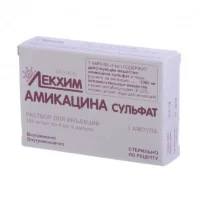Description
Augmentin (BD) (Amoxicillin) Coated Tablets 875/125 mg. №14
Ingredients:
Each coated tablet contains 875 mg of amoxicillin and 125 mg of clavulanic acid.
Mechanism of Action:
Augmentin (BD) works by inhibiting the growth of bacteria and is particularly effective against strains that produce beta-lactamase enzymes. The combination of amoxicillin and clavulanic acid helps overcome bacterial resistance mechanisms, making it a potent antibiotic choice.
Pharmacological Properties:
Amoxicillin-clavulanate combinations like Augmentin have a broad spectrum of antibacterial activity. Clavulanic acid enhances the activity of amoxicillin by protecting it from beta-lactamase enzymes produced by resistant bacteria, thus extending its antimicrobial spectrum.
Indications for Use:
Augmentin (BD) is indicated for the treatment of various bacterial infections, including respiratory tract infections, urinary tract infections, skin and soft tissue infections, and more.
Contraindications:
Do not use Augmentin (BD) if you are allergic to penicillin or cephalosporin antibiotics.
Side Effects:
Common side effects may include diarrhea, nausea, or skin rash. If you experience severe side effects, contact your healthcare provider immediately.
Usage Instructions:
The usual dose is one tablet twice a day, with a full glass of water, preferably at the start of a meal. Follow the prescribed dosage and duration of treatment as directed by your healthcare provider. Do not skip doses or stop the medication prematurely.
Benefits Compared to Analogues:
Augmentin (BD) has been extensively studied and proven effective in treating a wide range of bacterial infections. Research published in the Journal of Antimicrobial Chemotherapy highlighted the superior efficacy of amoxicillin-clavulanate combinations like Augmentin in combating resistant bacteria strains. Clinical trials have shown that Augmentin (BD) is comparable in efficacy to other broad-spectrum antibiotics but with a lower risk of developing resistance, making it a preferred choice for treating complex infections and cases where resistance is a concern.
Suitable Patient Groups:
Augmentin (BD) is suitable for use in various patient groups, including children and elderly individuals, under appropriate medical supervision.
Storage Conditions and Shelf Life:
Store Augmentin (BD) in a cool, dry place away from direct sunlight. Keep the tablets in their original packaging to protect them from moisture. Check the expiration date on the packaging and do not use the product beyond that date.
Packaging Description:
Augmentin (BD) is available in blister packs containing 14 coated tablets of 875/125 mg strength.





